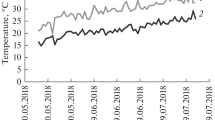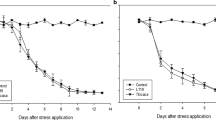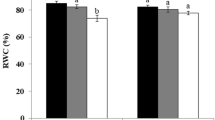Abstract
This study has analyzed the response of Ethiopian mustard (Brassica carinata A. Braun) to induced drought stress and subsequent rehydration in terms of plant growth, water status, chlorophyll concentration, chlorophyll fluorescence (F V /F M), net photosynthetic rate (Pn), transpiration rate (E), and stomatal conductance (g s). Potted plants were subjected to drought stress for 15 days and then to a daily irrigation for 5 days with 100 % field capacity (FC), and then extent of possible loss due to stress and gain due to rehydration was analyzed. The control population was maintained on normal watering schedule with 100 % FC. Drought stress reduced the growth rate of root and shoot, number of leaves, dimensions (width, length, and area) of leaves, and the biomass accumulation in different plant parts. With increase in drought stress, the relative water content, chlorophyll content, F V /F M, Pn, E, and g s were reduced. After rehydration, a complete or partial recovery was seen for all the parameters studied. On the whole, B. carinata employs a morpho-physiological drought-avoidance strategy.




Similar content being viewed by others
References
Abreu ME, Munné-Bosch S (2008) Salicylic acid may be involved in the regulation of drought-induced leaf senescence in perennials: a case study in field-grown Salvia officinalis L. plants. Environ Exp Bot 64:105–112
Anjum NA, Umar S, Iqbal M, Khan NA (2008) Growth characteristics and antioxidant metabolism of moongbean genotypes differing in photosynthetic capacity subjected to water deficit stress. J Plant Interact 3:127–136
Anjum NA, Ahmad I, Mahmood I, Pacheco M, Duarte AC, Pereira E, Umar S, Ahmad A, Khan NA, Iqbal M, Prasad MNV (2012) Modulation of glutathione and its related enzymes in plants’ responses to toxic metals and metalloids—a review. Environ Exp Bot 75:307–324
Aref MI, Ahmad AI, Khan PR, El-Atta H, Iqbal M (2013) Drought-induced adaptive changes in the seedling anatomy of Acacia ehrenbergiana and Acacia tortilis subsp. raddiana. Trees Struct Func 27:959–971
Ashraf M, McNeilly T (2004) Salinity tolerance in Brassica oilseeds. Crit Rev Plant Sci 23:157–174
Ashraf M, Mehmood S (1990) Response of four Brassica species to drought stress. Environ Exp Bot 30:93–100
Ashraf M, Ashraf MY, Khaliq A, Rha SH (2004) Growth and leaf gas exchange characteristics in Dalbergia sissoo Roxb. and D. latifolia Roxb. under water deficit. Photosynthetica 42:157–160
Athar H, Ashraf M (2005) Photosynthesis under drought stress. In: Pessarakli M (ed) Hand Book Photosynthesis, CRC Press, New York, USA, pp 795–810
Badruddin M, Rhaman MM, Nehar NA, Hossain MM, Hasan MB (2005) Physiological characterization of mustard (Brassica sp.) genotypes for their salt tolerance. Pak J Biol Sci 8:433–438
Bartels D, Sunkar R (2005) Drought and salt tolerance in plants. Crit Rev Plant Sci 24:23–58
Battisti DS, Naylor RL (2009) Historical warnings of future food insecurity with unprecedented seasonal heat. Science 323:240–244
Benincasa P, Pace R, Quinet M, Lutts S (2013) Effect of salinity and priming on seedling growth in rapeseed (Brassica napus var oleifera Del.). Acta Sci Agro 35:479–486
Bray EA, Bailey-Serres J, Weretilnyk E (2000) Responses to abiotic stresses. In: Gruissem W, Buchannan B, Jones R (eds) Biochemistry and molecular biology of plants. American Society of Plant Physiologists, Rockville, MD, pp 1158–1249
Clark LJG, Gowing DJ, Lark RM, Leeds-Harrison PB, Miller AJ, Wells DM, Whalley WR, Whitmore AP (2005) Sensing the physical and nutritional status of the root environment in the field: a review of progress and opportunities. J Agric Sci 143:347–358
CSA (Central Statistics Authority) (2003) Agriculture sample survey 2002/2003. Report on area and production for major crops. Statistical bulletin 200, CSA, Addis Ababa
Din J, Khan SU, Ali I, Gurmani AR (2011) Physiological and agronomic response of canola varieties to drought stress. J Anim Plant Sci 21:78–82
Du N, Guo W, Zhang X, Wang R (2010) Morphological and physiological responses of Vitex negundo L. var. heterophylla (Franch.) Rehd. to drought stress. Acta Physiol Plant 32:839–848
Duxbury AC, Yentsch CS (1956) Plankton pigment monograph. J Mar Res 15:93–101
Elsheery NI, Cao KF (2008) Gas exchange, chlorophyll fluorescence, and osmotic adjustment in two mango cultivars under drought stress. Acta Physiol Plant 30:769–777
Ezra M (2001) Demographic responses to environmental stress in the drought-and famine-prone area of northern Ethiopia. Int J Popul Geogr 7:259–270
Galmés J, Medrano H, Flexas J (2007) Photosynthesis and photoinhibition in response to drought in a pubescent (var. minor) and a glabrous (var. palaui) variety of Digitalis minor. Environ Exp Bot 60:105–111
Gan Y, Angadi SV, Cutforth H, Potts D, Angadi VV, McDonald CL (2004) Canola and mustard response to short period of high temperature and water stress at different developmental stages. Can J Plant Sci 84:697–704
Ghobadi M, Bakhshandeh M, Fathi G, Gharineh MH, Alamisaeed K, Naderi A, Ghobadi V (2006) Short and long periods of water stress during different growth stages of Canola (Brassica napus L.). effect on yield, yield components, seed oil and protein contents. Agron J 5:336–341
Gibon YR, Sulpice Larher F (2000) Proline accumulation in canola leaf discs subjected to osmotic stress is related to the loss of chlorophylls and to the decrease of mitochondrial activity. Physiol Plant 4:469–476
Grassi G, Magnani F (2005) Stomatal, mesophyll conductance and biochemical limitations to photosynthesis as affected by drought and leaf ontogeny in ash and oak trees. Plant Cell Environ 28:834–849
Hiruy B, Riley KW, Nigatu T, Getinet A (1983) The responses of three oilseeds Brassica species to different planting date and rate in highlands of Ethiopia. Ethiop J Agric Sci 5:22–33
Hiscox JD, Israelstam GG (1979) A method for extraction of chlorophyll from the leaf tissue without maceration. Can J Bot 57:1332–1334
Hosseini SM, Hassibi P (2011) Effects of water deficit stress on several quantitative and qualitative characteristics of Canola (Brassica napus L.) cultivars. Not Sci Biol 3:120–125
Husen A (2009) Growth, chlorophyll fluorescence and biochemical markers in clonal ramets of shisham (Dalbergia sissoo Roxb.) at nursery stage. New For 38:117–129
Husen A (2010) Growth characteristics, physiological and metabolic responses of teak (Tectona grandis Linn.f.) clones differencing in rejuvenation capacity subjected to drought stress. Silvae Gene 59:124–136
Husen A (2013) Growth characteristics, biomass and chlorophyll fluorescence variation of Garhwal Himalaya’s fodder and fuel wood tree species at the nursery stage. Open J For 3:12–16
Husen A, Khali R, Nautiyal S (2004a) Altitudinal variation in chlorophyll fluorescence/photosynthetic efficiency in seedlings of some indigenous fodder species. Ind For 130:89–94
Husen A, Khali R, Nautiyal S (2004b) Chlorophyll fluorescence in relation to diurnal changes of three Ficus species. Ind For 130:811–818
Issarakraisila M, Ma Q, Turner DW (2007) Photosynthetic and growth responses of juvenile Chinese kale (Brassica oleracea var. alboglabra) and Caisin (Brassica rapa subsp. parachinensis) to waterlogging and water deficit. Sci Hortic 111:107–113
Jamil M, Lee CC, Rehman SU, Lee DB, Ashraf M, Rha ES (2005) Salinity (NaCl) tolerance of Brassica species at germination and early seedling growth. Electron J Environ Agric Food Chem 4:970–976
Jamil M, Lee DB, Yung KY, Ashraf M, Lee SC, Rha ES (2006) Effect of salt (NaCl) stress on germination and early seedling growth of four vegetables species. J Cent Eur Agric 7:273–281
Janssen LHJ, Von Oeveren JC, Van Hassett PR, Kuiper PJC (1995) Genotypic variation in chlorophyll fluorescence parameters, photosynthesis and growth of tomato grown at low temperature and low irradiance. Photosynthetica 31:301–314
Kauser R, Athar HUR, Ashraf M (2006) Chlorophyll fluorescence: a potential indicator for rapid assessment of water stress tolerance in Canola (Brassica napus L.). Pak J Bot 38:1501–1509
Kranner I, Beckett RP, Wornik S, Zorn M, Pfeifhofer HW (2002) Revival of a resurrection plant correlates with its antioxidant status. Plant J 31:13–24
Kumar G, Purty RS, Sharma MP, Singla-Pareek SL, Pareek A (2009) Physiological responses among Brassica species under salinity stress how strong correlation with transcript abundance for SOS pathway-related genes. J Plant Physio 166:507–520
Lipiec J, Doussan C, Nosalewicz A, Kondracka K (2013) Effect of drought and heat stresses on plant growth and yield: a review. Int Agrophys 27:463–477
Lobell DB, Burke MB, Tebaldi C, Mastrandrea MD, Falcon WP, Naylor RL (2008) Prioritizing climate change adaptation needs for food security in 2030. Science 319:607–610
MacLachlan S, Zalick S (1963) Plastid structures, and chlorophyll concentration and free amino acid composition of a chlorophyll mutant of barley. Can J Bot 41:1053–1062
Mahajan S, Tuteja N (2005) Cold, salinity and drought stresses: an overview. Arch Biochem Biophys 444:139–158
Maggio A, De Pascale S, Angelino G, Riggiero C, Barbieri G (2004) Physiological response of tomato to saline irrigation in long-term salinized soils. Eur J Agron 21:149-159
Munné-Bosch S, Alegre L (2000) Changes in carotenoids, tocopherols and diterpenes during drought and recovery, and the biological significance of chlorophyll loss in Rosmarinus officinalis plants. Planta 207:925–931
Ortiz R, Sayre KD, Govaerts B, Gupta R, Subbarao GV, Ban T, Hodson D, Dixon JA, Ortiz-Monasterio JI, Reynolds M (2008) Climate change: can wheat beat the heat? Agric Ecosyst Environ 126:46–58
Pace R, Benincasa P (2010) Effect of salinity and low osmotic potential on the germination and seedling growth of rapeseed cultivars with different stress tolerance. Ital J Agro 5:69–77
Pan X, Lada RR, Calwell CD, Falk KC (2011) Water-stress and N-nutrition effects on photosynthesis and growth of Brassica carinata. Photosyn 49:309–315
Rosales-Serna R, Kohashi-Shibata J, Acosta-Gallegos JA, Trejo-López C, Ortiz-Cereceres J, Kelly JD (2004) Biomass distribution, maturity acceleration and yield in drought-stressed common bean cultivars. Field Crop Res 85:203–211
Sangtarash MH, Qaderi MM, Chinnappa CC, Reid DM (2009) Differential sensitivity of canola (Brassica napus) seedlings to ultraviolet-B radiation, water stress and abscisic acid. Environ Exp Bot 66:212–219
Saxe H, Cannell Melvin GR, Johnsen Ø, Ryan MG, Vourlitis G (2001) Tree and forest functioning in response to global warming. New Phytol 149:369–400
Schachtman DP, Goodger JQD (2008) Chemical root to shoot signaling under drought. Trends Plant Sci 13:281–287
Siddiqui SZ, Ajmal Khan M, Kim BG, Huang JS, Kwon T (2008) Physiological responses of Brassica napus genotypes to combined drought and salt Stress. Plant Stress 2:78–83
Sinaki JM, Heravan EM, Rad AHS, Noormohammadi G, Zarei G (2007) The effects of water deficit during growth stages of canola (Brassica napus L.). Am Eurasian J Agri Environ Sci 4:417–422
Tezara W, Marín O, Rengifo E, Martínez D, Herrera A (2005) Photosynthesis and photoinhibition in two xerophytic shrubs during drought. Photosynthetica 43:37–45
Uprety DC, Mishra RS, Abrol YP (1995) Effect of elevated CO2 on the photosynthesis, growth and water relation of Brassica species under moisture stress. J Agro Crop Sci 175:231–237
Velasco L, Nabloussi A, De Haro A, Fernández-Martínez JM (2003) Development of high-oleic, low-linolenic acid Ethiopian-mustard (Brassica carinata) germplasm. Theor Appl Genet 107:823–830
Voleti SR, Uprety DC (1997) Photosynthetic characteristics in Brassica carinata hybrids and their parents as influenced by moisture stress. Biol Plant 40:149–153
Wang Y, Frei M (2011) Stressed food—the impact of abiotic environmental stresses on crop quality. Agri Eco Environ 141:271–286
Yin C, Peng Y, Zang R, Zhu Y, Li C (2005) Adaptive responses of Populus kangdingensis to drought stress. Physiol Plant 123:445–451
Acknowledgments
We thank Gondar Agricultural Research Centre, Ethiopia, for providing authentic Ethiopian mustard seeds and the laboratory staff of Department of Biology, University of Gondar for nursery and laboratory assistant. AH is thankful to the President and Vice President (Academic, Research and Community Services) of the University of Gondar for creating instrumentation facility at the Botanical Sciences Research Laboratory in the Department of Biology.
Author information
Authors and Affiliations
Corresponding author
Rights and permissions
About this article
Cite this article
Husen, A., Iqbal, M. & Aref, I.M. Growth, water status, and leaf characteristics of Brassica carinata under drought and rehydration conditions. Braz. J. Bot 37, 217–227 (2014). https://doi.org/10.1007/s40415-014-0066-1
Received:
Accepted:
Published:
Issue Date:
DOI: https://doi.org/10.1007/s40415-014-0066-1




